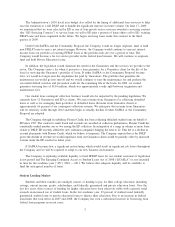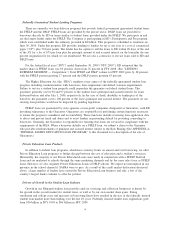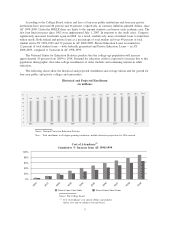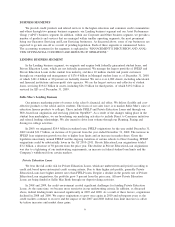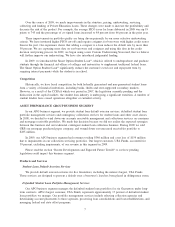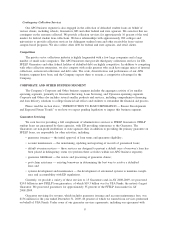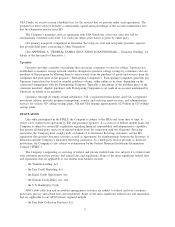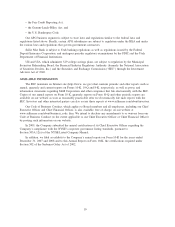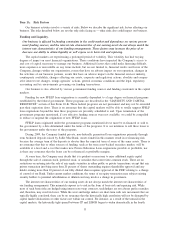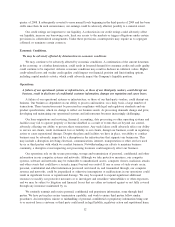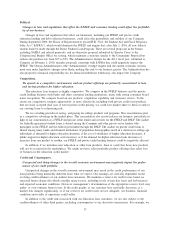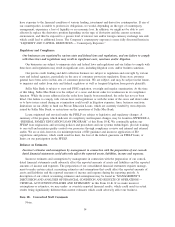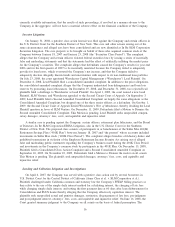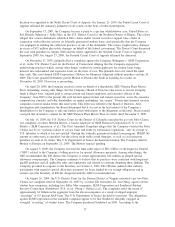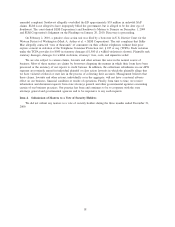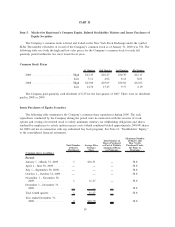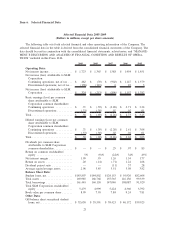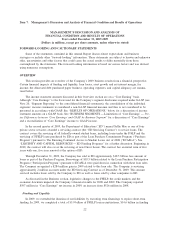Sallie Mae 2009 Annual Report Download - page 14
Download and view the complete annual report
Please find page 14 of the 2009 Sallie Mae annual report below. You can navigate through the pages in the report by either clicking on the pages listed below, or by using the keyword search tool below to find specific information within the annual report.Political.
Changes in laws and regulations that affect the FFELP and consumer lending could affect the profitabil-
ity of our business.
Changes in laws and regulations that affect our businesses, including our FFELP and private credit
education lending and debt collection businesses, could affect the profitability and viability of our Company.
During September 2009, the House of Representatives passed H.R. 3221, the Student Aid and Fiscal Responsi-
bility Act (“SAFRA”), which would eliminate the FFELP and require that, after July 1, 2010, all new federal
student loans be made through the Direct Student Loan Program. There are several proposals in the Senate,
including SAFRA and related proposals, and an alternative proposal submitted by Senator Casey to the
Congressional Budget Office for scoring, which maintains a structure similar to the Community Proposal but
reduces the purchase fee from $75 to $55. The Administration’s budget for the 2011 fiscal year, submitted to
Congress on February 1, 2010, includes proposals consistent with SAFRA that could negatively impact the
FFELP. The Obama Administration’s (the “Administration”) budget request and the current economic environ-
ment may make legislative changes more likely, making this risk to our business greater. The Administration has
also proposed a financial responsibility tax for financial institutions which may also impact the Company.
Competition.
We operate in a competitive environment, and our product offerings are primarily concentrated in loan
and savings products for higher education.
The education loan business is highly competitive. We compete in the FFELP business and the private
credit lending business with banks and other consumer lending institutions, many with strong consumer brand
name recognition. We compete based on our products, origination capability and customer service. To the
extent our competitors compete aggressively or more effectively, including with private credit loan products
that are more accepted than ours or lower private credit pricing, we could lose market share to them or subject
our existing loans to refinancing risk.
We are a leading provider of saving- and paying-for-college products and programs. This concentration gives
us a competitive advantage in the market place. This concentration also creates risks in our business, particularly in
light of our concentration as a FFELP and private credit lender and servicer for the FFELP and DSLP. The market
for federally-guaranteed student loans is shared among the Company and other private sector lenders who
participate in the FFELP, and the federal government through the DSLP. The market for private credit loans is
shared among many banks and financial institutions. If population demographics result in a decrease in college-age
individuals, if demand for higher education decreases, if the cost of attendance of higher education decreases, if
public support for higher education costs increases, or if the demand for higher education loans decreases or
increases from one product to another, our FFELP and private credit lending business could be negatively affected.
In addition, if we introduce new education or other loan products, there is a risk that those new products
will not be accepted in the marketplace. We might not have other profitable product offerings that offset loss
of business in the education credit market.
Credit and Counterparty.
Unexpected and sharp changes in the overall economic environment may negatively impact the perfor-
mance of our credit portfolio.
Unexpected changes in the overall economic environment may result in the credit performance of our
loan portfolio being materially different from what we expect. Our earnings are critically dependent on the
evolving creditworthiness of our student loan customers. We maintain a reserve for credit losses based on
expected future charge-offs which consider many factors, including levels of past due loans and forbearances
and expected economic conditions. However, management’s determination of the appropriate reserve level may
under- or over-estimate future losses. If the credit quality of our customer base materially decreases, if a
market risk changes significantly, or if our reserves for credit losses are not adequate, our business, financial
condition and results of operations could suffer.
In addition to the credit risk associated with our education loan customers, we are also subject to the
creditworthiness of other third parties, including counterparties to our derivative transactions. For example, we
13


